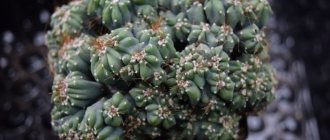Schlumbergera or Ripsalidopsis?
They are often confused, although they are two completely different plants. You need to be able to distinguish between them, this will reduce the likelihood that someone will mistakenly buy something that was not what they had planned. It is important to remember that there are basic signs that are easy to notice:
- Schlumbergera, also known as “Decembrist,” blooms in January;
- Different dormant seasons;
- The inflorescences of Zygocactus, another name for the winter cactus, have no scent;
- In ripsalidopsis, the leaf plates are smoothed along the edges, while in the “Decembrist” they are jagged (photo of leaves of ripsalidopsis and zygocactus).
What to do in preparation for the rest period?
After the cactus has bloomed, it remains with a bare peduncle . If you don’t touch it, it will either wither or grow and new flowers will appear. If the peduncle has dried out, it must be removed. Sometimes, immediately after the flowers have fallen, the peduncle is trimmed. Do this over the third node. The plant may produce a new peduncle or produce a young shoot.
After flowering there must be a period of rest. It begins immediately after flowering. The flowerpot with the flower should be taken outside to a shady place or to the balcony. It needs to be in the fresh air until September, this promotes further abundant flowering. From October to January, ripsalidopsis is left in a cool room. For lush flowering, it will need 80 cool days to form buds.
Plant species
There are many variations of this shrub, descriptions of the flower, so everyone will find what suits their personal taste. The most basic varieties are listed here:
Ripsalidopsis Gartner
The shrub is low - about 20-25 centimeters in height, its segments are longer than those of other species. It lends itself well to growing at home; beginners are advised to take it.
In addition, this variety has many varieties, so the choice is huge:
- 1.1. Yvonne Pelham
- 1.2. King's Dream
- 1.3. Evita
- 1.4. Nina
- 1.5. Sirius
- 1.6. Capella
- 1.7. Leach
Rhipsalidopsis pink
It has deep green stems with small segments. The segments can be smooth or slightly ribbed - it depends on the greenest friend. The inflorescences of the shrub grow about 5-6 centimeters and have a pink tint that is pleasant to the eye.
Ripsalidopsis Aurigo orange
Very similar to zygocactus due to the shape of its segments. It begins to bloom after the others; the inflorescences have a bright orange color, sometimes bordered with red along the edges of the petals.
Rhipsalidopsis Andromedia (Ripsalidopsis Andromeda)
Unlike many other species, it is bred artificially. Very beautiful when in bloom. Suitable for lovers of beauty and aesthetics.
Features of cacti of the genus Ripsalidopsis
The history of the genus Rhipsalidopsis is quite complicated. The "Easter cactus" has survived a number of scientific misconceptions. When the first plant species was first discovered and described (in 1884), it was classified as Epiphyllum, later renamed Schlumbergera, then transferred to the genus Rhipsalis, later Epiphilopsis, Rhipsalidopsis and then Hathiora. After numerous changes in taxonomy, cacti have recently been returned to the genus Schlumbergera, although they are still called Rhipsalidopsis, less commonly Hatiora.
The genus Rhipsalidopsis consists of only two species, Rhipsalidopsis gaertneri and Rhipsalidopsis rosea.
These two species belong to epiphytic cacti. They grow in the forests of Southern Brazil, in the states of Minas Gerais, Sao Paulo, Paraná, Santa Catarina and Rio Large del Sul. These places are close to the range of their relatives - cacti of the genus Schlumbergera.
Brief description of Rhipsalidopsis species
Although these two varieties of Easter cactus have almost the same appearance, there are still some differences between them:
- Rhipsalidopsis rosea (or "Dwarf Easter Cactus") is a compact, mostly erect, or often arching (or pendulous) cactus with articulated stems.
Photo of blooming Rhipsalidopsis rosea Flattened stem segments, from 2 to 4 centimeters in length and 1 centimeter in width, during the flowering period (spring) the cactus blooms pink flowers with a diameter of 3 to 4 centimeters. This species was described in 1912 by Lagerheim. - Ripsalidopsis Gartner it is a larger, highly branched epiphytic cactus with a diameter of 30-40 cm with flat stems divided into segments with jagged edges.
Photo of Ripsalidopsis or Schlumberger Gartner
The terminal segments often droop. This species has larger stem segments, from 4 to 7 centimeters in length and from 2 to 2.5 centimeters in width. Bright red flowers, 4 cm long, appear in large numbers in spring, singly or in groups. This species has been described since 1884 by the German botanist von Regel.
What are the differences between cacti of the genus Ripsalidopsis and Schlumbergera or Decembrist
Although two Rhipsalidopsis species have recently been classified as Schlumbergera, there are some visual and flowering differences between them. Due to their external similarity, they are often confused. This often leads to the fact that you may be sold a Schlumberger cactus instead of Ripsalidopsis. Moreover, there are two similar varieties of Zygocactus - Schlumbergera bridgesii and Schlumbergera truncata, which also differ slightly from each other. How can you tell them apart?
- First of all, this is the flowering period. Rhipsalidopsis blooms in the spring, often during the Easter holidays, which is why it is called the “Spring Cactus” or “Easter Cactus”. Schlumbergera blooms in early winter, before the New Year holidays, accordingly it is called the “Christmas cactus”, “Rozhdestvennik” or “Decembrist”.
- The dormant period is also different - for Decembrist it occurs in February–March, and for Ripsalidopsis from late October to mid-winter.
- Dimensions and appearance of stem segments . Schlumberger's has denticles at the edges of its stems, while Easter Cactus has segments with fine bristles and a smoother, wavy ridge.
If you are planning to acquire this wonderful succulent, pay attention to these features of different species so that you know which plant you are purchasing.
Ripsalidopsis care
Caring for a rhipsalidopsis plant at home will require patience and perseverance. However, if you do everything correctly, the result will not be long in coming.
Location in the house
Find a window in the apartment facing north or southeast. If this is not possible, then you can place it in any place at a distance of about a meter from the glass. If the plant is on the north side, then from time to time it needs to be turned in different directions towards the sunlight.
But, an important point, if the bush has buds, under no circumstances should it be touched, otherwise all the inflorescences will fall off. In warm summer months, ripsalidopsis can be taken out to the balcony, as they love fresh air. But it is important to protect them from rain, strong winds and direct sunlight.
Lighting
Ripsalidopsis do not tolerate direct sunlight, so they should be placed in partial shade. By the way, lighting greatly affects them: they can change color depending on the level of light maintained in the room.
Temperature
They have a hard time withstanding temperature changes and heat. In spring and summer, the ideal temperature for them is 18-20 degrees, in the fall it should be lowered to 10-12, and from October to February, maintain 12-15 degrees. This is required to help the plant bloom next season.
Watering and humidity
How to water a flower is one of the most common questions. The cactus loves abundant watering during flowering. Even if the soil seems dry in the area of 1-2 centimeters in depth, it should be moistened with soft, filtered water.
But such careful care is needed only in spring: after the end of the flowering period of the bush, you need to reduce watering. Water should not be left in the pan after watering, this will lead to the death of the roots.
As for humidity, it needs to be maintained at a high level: spray near it in the morning and evening, and in hot and stuffy weather, organize warm, gentle watering. While the flower is dormant, it is enough to wipe the petals from dust with a damp cloth.
The soil
Soil for ripsalidopsis needs to be purchased at a flower stall. Particular attention is paid to the acidity of the substrate - it should not exceed pH 5.5-6 units, the substrate itself needs to be loose, containing large organic pieces, but if it is possible to make the substrate yourself, then it is better to do this.
For it you will need:
- 1 share of turf land with a small clay content in it;
- 1 share of fine gravel;
- 2 shares of garden humus;
- Some crushed charcoal;
- Superphosphate.
Mix all this and the substrate is ready.
Top dressing
They are not particularly whimsical about this. Any fertilizer for cacti that can be found in a flower shop will do. It is recommended to fertilize once every six months.
Transfer
You need to replant ripsalidopsis once a year for the first three years, then once every two to three years is enough, since its intensive growth ends. It is better to replant immediately after flowering and before the dormant period begins.
Flowering phase
It mainly begins in the spring and does not last a long period of time. It happens that the cactus does not bloom at all. The reason for this may be a lack of nutrients in the soil, improper lighting, excessive watering, or an uncomfortable temperature for the shrub.
How to get Rhipsalidopsis to bloom
Flowering of the "Easter cactus" is caused by both a limited amount of light and fairly low temperatures. Your plant needs equal amounts of darkness and light for eight weeks before spring bloom. At night, aim for cooler, drier conditions, ideally around 13-16°C. And although these plants like warmth, do not place your cactus pot near any heat sources. Starting around January, you should close the curtains completely and turn off all the lights in the room the cactus is in after sunset.
Once buds begin to form, plants should not be moved to a new location with radically different light or temperature conditions, as many of the buds will stop developing and their flowering will be interrupted. Flowers will take longer to open if they are not exposed to high temperatures. Plants should bloom for 2-3 weeks at temperatures around 21°C.
Reproduction
Can be done in several ways.
The first is cuttings. A familiar and simple method to all of us. For the cutting, choose a stem with two or three segments; it must be immediately placed in the soil and then put in the shade.
The second is seeds. You can get them at any botanical market. You cannot wet them and store them in a wet cloth, as is done with many plants. In order for the seeds to germinate, it is enough to place them in a peat mixture, maintaining the soil at a certain level of moisture. As soon as the seedlings begin to appear, they can be transplanted into pots.
And the last, most difficult method is vaccination. Without experience and knowledge, this procedure will not be possible, so it is better to contact a specialist.
Difficulties in growing
Any violation of the regime of agrotechnical measures and microclimatic conditions when growing ripsalidopsis leads to problems with plant development. Most often, flower growers are faced with a lack of flowering and the spread of pests.
Why doesn't it bloom
Ripsalidopsis may not bloom for several reasons:
- lack of nutrition during the growing season - feed the plants 2 times a month with fertilizers containing potassium and phosphorus;
- excess nitrogen - add soil to the pot, add dolomite flour 3 g per plant, if the shoots turn yellow, carry out an urgent replanting with the addition of potassium monophosphate 3 g per plant to the soil.
Diseases and pests
There are many reasons why rhipsalidopsis may not be doing well. This could be fungal or bacterial diseases, it could be improper indoor care, pests, and more.
Most often, the plant becomes a victim of spider mites, mealybugs and other parasites. They are located on the bottom of the sheet, so you won’t notice them at first glance.
A splash of laundry soap will help against a small number of parasites: wipe the damaged side with it and, after checking the soil for pests, cover it with something for a while. But if there are still a lot of insects, then it is better to use special means.
Ripsalidopsis are moisture-loving, so they are at risk of fungal diseases. It is very easy to notice that a plant is infected: slimy, gray spots will appear on its leaves. If the fungus has not yet grown, then you can treat the leaves with a fungicide, but in case of advanced disease, it is better to select intact shoots and root them.
However, a person himself may be responsible for the death of his green friend. Excess moisture can negatively affect the root, so if outwardly there are no symptoms described above, you should check the lower part of the bush.
Rotting roots need to be cut off, as they are a threat to the whole thing, and then the cactus must be transplanted into new soil.
Reasons why flowering does not occur
Flowering begins from April to May. If this does not happen, errors in care were made.
The most common reasons for lack of flowering:
- The room temperature is too low.
- Untimely transplant.
Young individuals are replanted annually after the cactus has bloomed. Otherwise, it will not have the strength to bloom. Adult plants need replanting once every three years, or you can simply add soil. - Overflow or lack of light. You need to make sure that the water does not stagnate in the pan. Spray the flower daily.
- Lack of nutrients. It is better to choose fertilizers rich in phosphorus or potassium. They stimulate the birth of buds.
A large amount of nitrogen in fertilizers inhibits the formation of buds.
Cactus selection
This should be taken very carefully. You need to choose a healthy plant, so before purchasing, carefully inspect its leaves for spots and pests. If the purchase takes place in winter, then pay special attention to the general appearance and condition of the plant - the bush should look stable and healthy.
It is possible that at first the cactus will not feel well in the new place, but this is normal, since moving is stressful. Well, and most importantly, you should choose what you like so that leaving is a joy.
How to make a cactus form buds?
To stimulate the appearance of buds, you should make a temperature difference . It must be reduced to four degrees. Special devices that can be purchased at flower shops will help you do this.
Many beginners discover that the ideal conditions created for the plant did not give the desired result. The reason may be that the cactus directed all its forces into growth and stopped throwing out buds. You can speed up flowering by moving the plant to a cooler place or reducing watering.
Photo of the plant Ripsalidopsis
Signs and superstitions
There are several signs and superstitions associated with the Easter cactus:
- If rhipsalidopsis blooms on Easter, the family will experience good luck and prosperity.
- For lonely girls, the beginning of the cactus flowering, which coincides with Easter, promises a fateful meeting.
- If the plant has dropped its buds, there is a black stripe ahead.
- Seeing a blooming Easter egg in a dream means good luck and profit.
When growing ripsalidopsis, the main task of the grower is to create a comfortable indoor microclimate and follow basic cultivation rules, taking into account the origin of this plant. The Easter cactus requires especially careful care during the flowering period.











